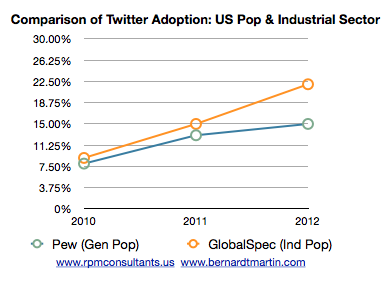
Be sure and check for comments there as well.
Way back on March 21, 2011 Twitter celebrated it’s 5th birthday: “200 million users and 1 billion tweets per week”. Had it hit the mainstream audience and what was the adoption rate in the industrial sector? In November 2010 Pew Internet & American Life Project surveyed more than 2,200 US adult web users and asked, “Do you use Twitter?” Their findings: 8% of all respondents said yes. But quite a lot has changed since those days.
However, it’s important within the context of what adoption rates really mean. So let’s first explore that first and then review some of the historical data now that their is actually some historical data available.
What’s an Early Adopter?
| An “early adopter” is an early consumer of a technology; in politics, fashion, art, and other fields, this person would be referred to as a trendsetter. The concept was outlined in Everett M. Rogers‘ 1962 study “Diffusion of Innovations” Although the segmentation of what defines an early adopter has been modified over time, Rogers felt that the crux point between “early adopter” and the next phase, “early majority”, was around 15%. |
| By Roger’s standards, in 2011, Twitter was in the “early adopter” phase within US population. As computers, the internet and electronic technology began to take hold in the 80’s & 90’s Geoffrey A. Moore defined “The Chasm” in early adoption. |
Manufacturing Sector Twitter adoption
The 2011 study was quite revealing. It indicated “Currently, only 15 percent have a Twitter account” GlobalSpec’s recommendations for using Twitter where, to say the least, in the “not recommended” category.
By early 2012 marketing adoption, according a new updated report, “Social Media Usage in the Industrial Sector” was released from GlobalSpec. According to that report, Twitter usage had now increased to 22% amongst respondents to the survey.
Population Twitter adoption
Comparing the Statistics
| When we overlay the data from both studies what we find is the the industrial sector seems to be adopting Twitter more quickly than the general population. Both have now “crossed the chasm” Let’s just summarize for a moment what the data tells us:
|
- Comparison between different population studies is always prone to error and we need to acknowledge that.
- Within the Industrial sector there are business “silos” (vertical markets) that include, not only the entire supply chain, but also the end user base of customers. The “industrial population” data from GobalSpec does not contain ‘refined data’ for these individual vertical silos.
What that means
What we have observed
However, based upon our observation (because segmented analytics are near impossible to obtain or analyze) these industry silo’s vary in adoption. Of course both have a significant involvement in Twitter at the equipment manufacturer level but from there the segments begin to vary. Whereas the ‘woodworking’ sector has a good many woodworking (end user) shops with a Twitter presence the metalcutting and fabricating sector has little participation at the ‘end user” level, comparatively speaking.




 RSS Feed
RSS Feed